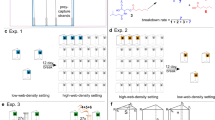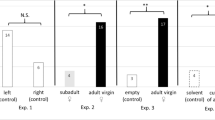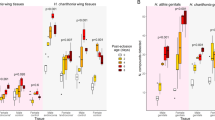Abstract
Assessments and decision-making underlying the initiation of mate guarding in a common web-building spider, Metellina segmentata, are examined in a series of field and laboratory studies. Adult males do not build webs but wander in search of females and mating opportunities. Adult males then wait at the edge of the webs of females and guard them prior to courtship and mating. Guarded females were heavier, larger and carried more mature eggs than solitary females. An active process of information gathering is apparent from introductions of males to the webs of females. Males make accurate assessments about female quality, even in the absence of the resident female. Cues involving web architecture are not used. Males may assess pheromonal cues on the web of the female in deciding whether to guard or abandon a female.
Similar content being viewed by others
References
Barth FG (1982) Spiders and vibratory signals: sensory reception and behavioural significance. In: Witt PN, Rovner JS (eds) Spider communication, mechanisms and evolutionary significance. Princeton University Press, Princeton, pp 67–122
Blanke R (1974) Rolle der Beute beim Kopulationsverhalten von Meta segmentata (Cl.) (Araneae, Araneidae). Forma Functio 7:83–94
Bristowe WS (1929) The mating habits of spiders, with special reference to the problems surrounding sex dimorphism. Proc Zool Soc London 1929:309–358
Bristowe WS (1958) The world of spiders. Collins, London
Christenson TE (1984) Alternative reproductive tactics in spiders. Am Zool 24:321–332
Dick JTA (1992) Simultaneous manipulations of two potential mates by male Gammarus pulex (Amphipoda): A mechanism of active mate choice. Crustaceana 62:717–722
Dick JTA, Elwood RW (1990) Symmetrical assessments of female quality by male Gammarus pulex (Amphipoda) during struggles over precopula females. Anim Behav 40:877–883
Elgar MA, Nash DR (1988) Sexual cannibalism in the garden spider Araneus diadematus. Anim Behav 36:1511–1517
Elwood, RW, Neil SJ (1992) Assessments and decisions. A study of information gathering by hermit crabs. Chapman and Hall, London
Harper DGC (1985) Pairing strategies and mate choice in female robins Erithacus rubecula. Anim Behav 33:375–380
Harvey PH, Bradbury JW (1991) Sexual selection. In: Krebs JR, Davies NB (eds) Behavioural ecology, an evolutionary approach. Blackwell, Oxford, pp 203–233
Krebs JR, Davies NB (1993) An introduction to behavioural ecology. Blackwell, Oxford
Olive CJ (1982) Sex pheromones in two orbweaving spiders (Araneae, Araneidae): an experimental field study. J Arachnol 10:241–245
Parker GA (1974) Assessment strategy and the evolution of fighting behaviour. J Theor Biol 47:223–243
Pollard SD, Macnab AM, Jackson RR (1987) Communication with chemicals: pheromones and spiders. In: Nentwig W (ed) Ecophysiology of spiders. Springer, Berlin Heidelberg New York, pp 133–144
Prenter J, Elwood RW, Colgan S (1994) The influence of prey and female reproductive state on the courtship of the autumn spider Metellina segmentata: a field experiment. Anim Behav 47:449–456
Rubenstein DI (1987) Alternative reproductive tactics in the spider Meta segmentata. Behav Ecol Sociobiol 20:229–237
Schulz S, Toft S (1993) Identification of a sex-pheromone from a spider. Science 260:1635–1637
Suter RB, Renkes G (1982) Linyphiid spiders courtship releaser and attractant functions of a contact pheromone. Anim Behav 30:714–718
Tietjen WJ, Rovner JS (1982) Chemical communication in spiders. In: Witt PN, Rovner JS (eds) Spider communication: mechanisms and ecological significance. Princeton University Press, Princeton, pp 249–279
Uetz GW, Stratton GE (1983) Communication in spiders. Endeavour 7:13–18
Watson PJ (1986) Transmission of a sex pheromone twarted by males in the spider Linyphia litigiosa (Linyphiidae). Science 233:219–221
Witt PN (1975) The web as a means of communication. Bioscience 1:7–23
Witt PN (1982) Communication in spiders. In: Witt PN, Rovner JS (eds) Spider communication, mechanisms and ecological significance. Princeton University Press, Princeton, pp 3–14
Author information
Authors and Affiliations
Rights and permissions
About this article
Cite this article
Prenter, J., Elwood, R.W. & Montgomery, W.I. Assessments and decisions in Metellina segmentata (Araneae: Metidae): evidence of a pheromone involved in mate guarding. Behav Ecol Sociobiol 35, 39–43 (1994). https://doi.org/10.1007/BF00167058
Received:
Accepted:
Issue Date:
DOI: https://doi.org/10.1007/BF00167058




